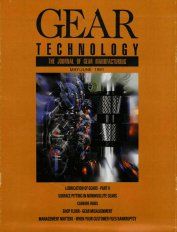Spur gear endurance tests were conducted to investigate the surface pitting fatigue life of noninvolute gears with low numbers of teeth and low contact ratios for the use in advanced application. The results were compared with those for a standard involute design with a low number of teeth. The gear pitch diameter was 8.89 cm (3.50 in.) with 12 teeth on both gear designs. Test conditions were an oil inlet temperature of 320 K (116 degrees F), a maximum Hertz stress of 1.49 GPa (216 ksi), and a speed of 10,000 rpm. The following results were obtained: The noninvolute gear had a surface pitting fatigue life approximately 1.6 times that of the standard involute gear of a similar design. The surface pitting fatigue life of the 3.43-pitch AISI 8620 noninvolute gear was approximately equal to the surface pitting fatigue life of an 8-pitch, 28-tooth AISI 9310 gear at the same load, but at a considerably higher maximum Hertz stress.
